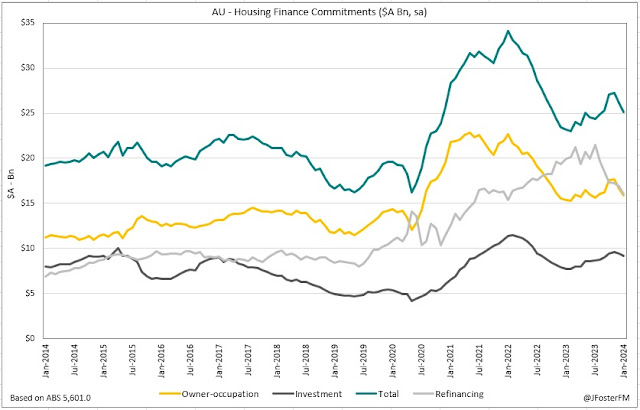The value of Australian housing finance commitments fell by 3.9% in January to $25.1bn. This follows a sizeable fall in December (-4.1%). These declines may be driven by seasonality, abruptly halting an uptrend in commitments through 2023. That said, renewed concerns around housing affordability and a further RBA rate rise in November - increasingly looking to be the last for the cycle - could also be relevant factors.
Housing finance commitments fell by 7.9% over December-January, retracing to their lowest level ($25.1bn) since August 2023. Heightened volatility across a range of economic data sets around the turn of the year has suggested that there may be some issues with the ABS's seasonal adjustment processes, by extension a potential factor in this series as well. In January, commitments fell to owner-occupiers (-4.6%) and investors (-2.6%), both segments posting back-to-back declines following contractions of 5.6% and 1.6% respectively in December.
The fall in owner-occupier lending in January was broad based: upgraders -5.2% (on a 2.3% fall in loan volumes), construction-related -2.4% (-4.2%) and first home buyers -6% (-6.9%); alterations went against the trend rising modestly by 0.7%.
Lending to the investor segment declined by 4.1% over December-January but at $9.2bn was still 18.5% above its level a year ago. The state figures show the fastest growth through the past 12 months has come in Western Australia (63.1%) and South Australia (41.7%).
In the refinancing segment, activity slowed further in January. Total refinancing fell by 5% in the month to $16.1bn, posting its 6th consecutive decline. Refinancing declined by 7.4% for owner-occupiers ($10.3bn) and 0.5% for investors ($5.8bn). The slide over recent months is an unwind from an earlier surge in activity alongside the RBA's tightening cycle.








